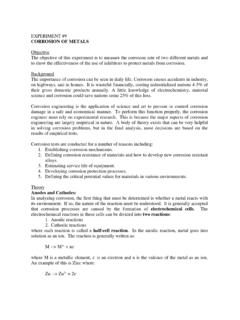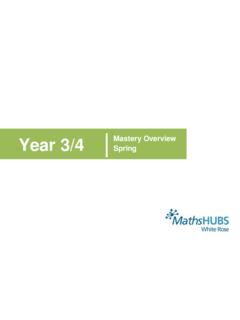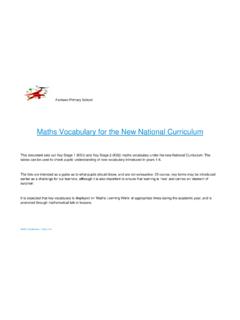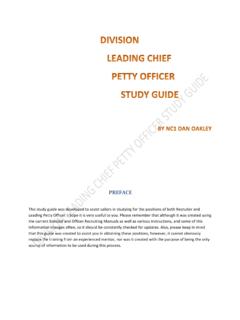Transcription of SUGI 26: Format Challenges with PROC REPORT
1 1 Format Challenges with PROC REPORTLisa M. Schneider, Covance Inc., Princeton, NJABSTRACTPROC REPORT is a very useful tool in the production of tables,particularly if the data to be presented in the column contain thesame kind of information for all rows in the table. A morechallenging situation arises when different types of data ( ,discrete and continuous variables) are used in the same columnto represent dissimilar information that often needs to bedifferentially displayed. If the REPORT also requires the use of aclassification variable to define columns of the REPORT , morecomplications can use of COMPUTE statements and an ACROSS variable tohandle these conditions is explored. COMPUTE statementsconditionally assign different formats to the various datapresented in the same column based on the values of variablesused to distinguish the rows in the table.
2 An ACROSS variable isused to define the classification structure for the that the REPORT procedure actually transposesthe input data set when an ACROSS variable is used, and thuschanges the names of the variables, is crucial to the constructionof COMPUTE statements. The usefulness of the OUT= option ofthe procedure is 1 is from a table that displays two different kinds ofvariables (one continuous and one discrete) as well as differentkinds of information to be displayed for each variable type. Inaddition, there are two groups across the page. Each variablehas two columns for each group in which the actual data valuesare displayed. The example shows that each of the two columnsdisplaying data values within each group has four separateformats used to present the information required in the purpose of this paper is to demonstrate the use of aCOMPUTED variable in PROC REPORT to assign differentformats within a single column appropriate for the informationdisplayed in each row.
3 These columns of data will be repeatedfor two levels of a classification variable with the use of anACROSS OF THE INPUT DATA SETPROC REPORT can easily display data for different levels of aclassification variable across the page. The data to be presentedin the REPORT for different levels of any classification variable canbe separate observations in the input data set. It is not arequirement that all the data values for an actual row in the reportbe on the same observation of the input data set. The input dataset to PROC REPORT can thus be vertical (or normalized)instead of the example above, the input data with the statistics (SEQ=1through 5) for the continuous variable AGE (PRNTORD=1) for thetwo groups (CLASSVAR=1 or 2) and their associated twocolumns of data (LEFTCOL and RGHTCOL) are given in Figure2.
4 The levels (also SEQ=1 through 5) of the discrete variableRACE (PRNTORD=2) and their data are also VARIABLESThe ACROSS variable in PROC REPORT takes a vertical inputdata set and transposes it horizontally to display the separateobservations across the page. Each column under an ACROSS variable is determined by the value of the ACROSS variable (inthis example, CLASSVAR) as well as the value of anothervariable (in this example, either LEFTCOL or RGHTCOL). Thus,two variables collectively define what data appear in the the transpose has taken place, the variables involved in theACROSS process no longer have their original names. This isbecause each column is a combination of two variables and eachlevel of the ACROSS variable will generate new columns as thedata set becomes horizontal.
5 Given that there has to be a way todirectly reference any given column, PROC REPORT renamesthese new columns as _Cx_ where x is the number of the newcolumn that the combination of variables columns are sequentially numbered starting with the firstvariable in the COLUMN statement and increment by one aseach new variable (excluding the ACROSS variable) appears inthe COLUMN statement. The transpose also produces newcolumns for each level of the ACROSS variable and the variables under it. These columns are included in the sequentialnumbering scheme. In this way, PROC REPORT can uniquelyreference each column required in the actual REPORT . The columnsdefined by an ACROSS variable and another variable can bereferenced by a single variable OUT=SAS-DATA-SET OPTIONA lthough the column names after the transpose can bedetermined as explained above, it is sometimes much easier tojust output the data set created by PROC REPORT and look atthe column names.
6 To do this use the OUT=SAS-data-set optionon the PROC REPORT statement. The output data set can thenbe printed and examined to see how the columns have with the example above, a simple PROC REPORT (Figure 3) will produce a REPORT without the special formatting ofeach row. Outputting and printing the data set created shows thenames of the new columns after the transpose from the ACROSS variable has been about the PROC REPORT code The comma after CLASSVAR (the ACROSS variable) andthe parentheses surrounding LEFTCOL and RGHTCOL indicate to PROC REPORT that the combination of thosevariables collectively will determine the contents of thecolumns. This is the usual setup for an ACROSS variableand the variables under it.
7 When an ACROSS variable is used, the variablesPRNTORD and SEQ must be defined as GROUP so thatthe summary process of GROUP collapses the observationsinto a single row in the REPORT (as opposed to the detailrecords that would be produced if these variables weredefined as ORDER). When a DISPLAY and an ACROSS variable share acolumn, the REPORT must also contain another variable that isnot in the same column. Also, an ACROSS variable withouta statistic or an analysis variable associated with it willproduce an error. (Since LEFTCOL and RGHTCOL arebeing used as DISPLAY variables in this example, there isno other numeric variable to use as ANALYSIS.) Thevariable FOOLRPT is used to resolve these issues.
8 Thisvariable is not on the input data set and is by default anANALYSIS variable. PROC REPORT will create thevariable and use it as the REPORT is ' Corner2 Figure 4 presents the OUT=OUTRPT data set. As can be seen,the variable names for the columns involved in the ACROSS transpose process are _C3_ and _C4_, for the LEFTCOL andRGHTCOL variables respectively, for CLASSVAR=1observations and _C5_ and _C6_ for CLASSVAR= THE ACTUAL REPORTThe entire code for producing the output shown in Figure 1 isincluded as Figure 5. Important details will be discussed The COLUMN statement is expanded to include three newCOMPUTED variables. (See the associated DEFINE statements.)
9 LEFTHEAD contains the formatted text to indicate whatdata is displayed in the row. The values are theformatted versions of the combination of PRNTORDand SEQ. NEWLEFT and NEWRGHT are the two differentiallyformatted versions of the variables LEFTCOL andRGHTCOL, respectively, for each of the two levels ofthe classification variable CLASSVAR. The DEFINE statements for PRNTORD and SEQ have theirusage as GROUP. In addition, these variables are notprinted. They are used to sort and group the observationsaccordingly. In combination with the ACROSS variable,GROUP summarizes the separate input observations into asingle observation in the REPORT . All observations with thesame values for the PRNTORD and SEQ variables are onerow in the REPORT .
10 PRNTORD and SEQ are also used toapply different formats to the rows. LEFTCOL and RGHTCOL both have the NOPRINT variables are used as the data source for which theCOMPUTED variables apply the appropriate formats. Two versions of COMPUTE blocks are used in this PROCREPORT. The first type ( , the COMPUTE BEFORE blocks for each variable) is used to copy the values of thePRNTORD and SEQ variables into variables (ORDPRNTand SEQUENCE, respectively) used in the COMPUTED variables. This is necessary because PROC REPORT doesnot have access to the values of the original PRNTORD andSEQ variables as it continues to build the REPORT from left toright. In the COMPUTE block for PRNTORD, there is alsocode to generate the first row for each of the variablesin the REPORT .















